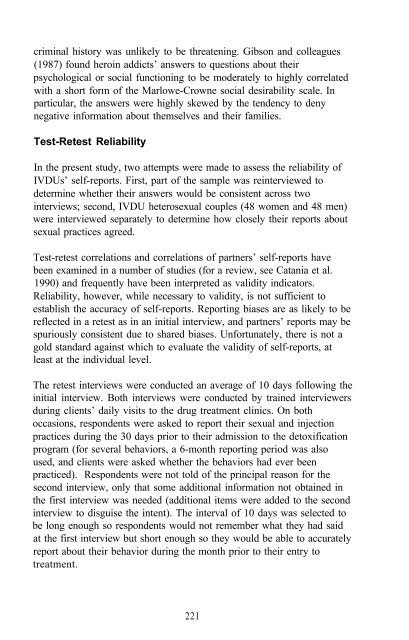The Context of HIV Risk Among Drug Users and Their Sexual Partners
The Context of HIV Risk Among Drug Users and Their Sexual Partners
The Context of HIV Risk Among Drug Users and Their Sexual Partners
Create successful ePaper yourself
Turn your PDF publications into a flip-book with our unique Google optimized e-Paper software.
criminal history was unlikely to be threatening. Gibson <strong>and</strong> colleagues<br />
(1987) found heroin addicts’ answers to questions about their<br />
psychological or social functioning to be moderately to highly correlated<br />
with a short form <strong>of</strong> the Marlowe-Crowne social desirability scale. In<br />
particular, the answers were highly skewed by the tendency to deny<br />
negative information about themselves <strong>and</strong> their families.<br />
Test-Retest Reliability<br />
In the present study, two attempts were made to assess the reliability <strong>of</strong><br />
IVDUs’ self-reports. First, part <strong>of</strong> the sample was reinterviewed to<br />
determine whether their answers would be consistent across two<br />
interviews; second, IVDU heterosexual couples (48 women <strong>and</strong> 48 men)<br />
were interviewed separately to determine how closely their reports about<br />
sexual practices agreed.<br />
Test-retest correlations <strong>and</strong> correlations <strong>of</strong> partners’ self-reports have<br />
been examined in a number <strong>of</strong> studies (for a review, see Catania et al.<br />
1990) <strong>and</strong> frequently have been interpreted as validity indicators.<br />
Reliability, however, while necessary to validity, is not sufficient to<br />
establish the accuracy <strong>of</strong> self-reports. Reporting biases are as likely to be<br />
reflected in a retest as in an initial interview, <strong>and</strong> partners’ reports may be<br />
spuriously consistent due to shared biases. Unfortunately, there is not a<br />
gold st<strong>and</strong>ard against which to evaluate the validity <strong>of</strong> self-reports, at<br />
least at the individual level.<br />
<strong>The</strong> retest interviews were conducted an average <strong>of</strong> 10 days following the<br />
initial interview. Both interviews were conducted by trained interviewers<br />
during clients’ daily visits to the drug treatment clinics. On both<br />
occasions, respondents were asked to report their sexual <strong>and</strong> injection<br />
practices during the 30 days prior to their admission to the detoxification<br />
program (for several behaviors, a 6-month reporting period was also<br />
used, <strong>and</strong> clients were asked whether the behaviors had ever been<br />
practiced). Respondents were not told <strong>of</strong> the principal reason for the<br />
second interview, only that some additional information not obtained in<br />
the first interview was needed (additional items were added to the second<br />
interview to disguise the intent). <strong>The</strong> interval <strong>of</strong> 10 days was selected to<br />
be long enough so respondents would not remember what they had said<br />
at the first interview but short enough so they would be able to accurately<br />
report about their behavior during the month prior to their entry to<br />
treatment.<br />
221
















